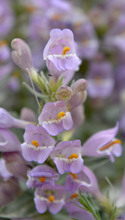This is an archived article that was published on sltrib.com in 2013, and information in the article may be outdated. It is provided only for personal research purposes and may not be reprinted.
The U.S. Fish and Wildlife Service has proposed listing two rare plant species, both endemic to the Uinta Basin, for federal protection under the Endangered Species Act.
Graham's beardtongue and White River beardtongue, which grace eastern Utah's barren landscapes with pink and lavender blossoms in the spring, warrant listing as threatened because their range has been reduced by oil and gas development, invasive species and grazing, according to the proposal posted Monday on the Federal Register.
These beardtongue species grow mostly on Utah's "Mahogany ledge" where oil shale deposits rich in calcium carbonate touch the surface, according to Bekee Hotze of the service's Utah office. The state's energy industry is eager to mine this resource which underlies the Uinta Basin in great abundance.
"Listings for these species have been pending for 30 years. It's about time. It's been through two lawsuits. No other plant species parallels what it has gone through to this point," said Tony Frates, conservation co-chairman for the Utah Native Plant Society.
Frates' group had successfully challenged the service's 2006 decision withdrawing Graham's beardtongue from consideration as a protected species.
Beardtongue, also known as penstemon, are shrubby perennial members of the figwort family.
Fish and Wildlife's new proposed listings seeks to designate 68,000 acres of critical habitat, two-thirds of which is federal land, for Graham's beardtongue. About 40 percent of the 15,000 acres to be designated for the rarer White River beardtongue is federal. Most of this land is in Uintah County, with some in neighboring Colorado and Duchesne County.
Designated habitat on state and private land will have little impact on how the land is used should the listings become final, according to Larry Crist, who supervises the service's Utah field office.
"Unless there is a federal nexus there is no protection," Crist said. Some of the proposed habitat does overlap lands leased for oil shale development, which often requires strip mining.
Monday's posting opens a 60-day public comment period until Oct. 7 with a final decision a year out. Before finalizing critical habitat, the service will apply an economic impact model to ensure benefits outweigh the cost of designation, officials said.
Critical habitat designation does not preclude development, but in the case of beardtongue it would obligate the Bureau of Land Management to consult with Fish and Wildlife before authorizing any new projects on these lands to explore way to minimize impacts to the plant.





